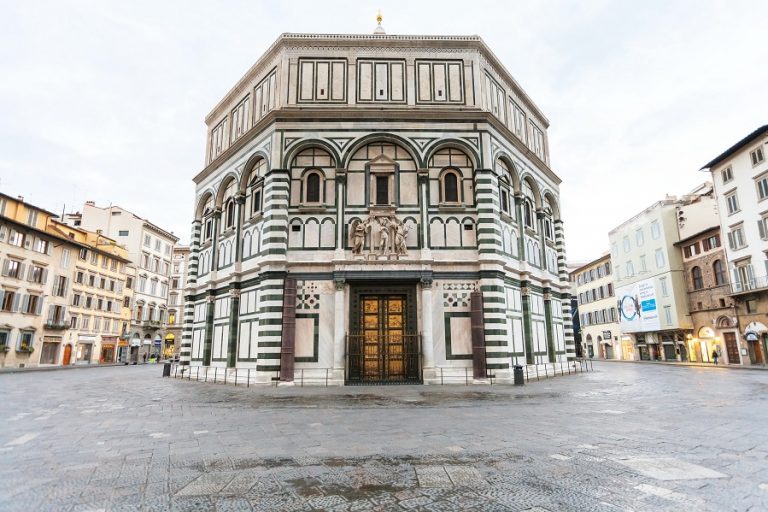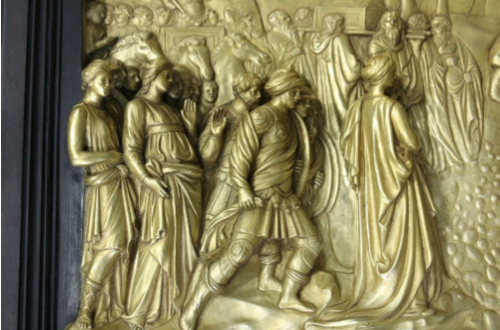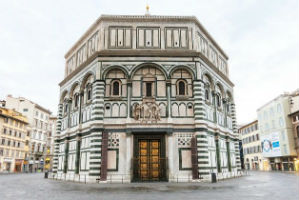
KANSAS CITY, Mo. – A massive pair of monumental bronze doors considered to be the defining moment of the Italian Renaissance will be installed this month at the Nelson-Atkins Museum of Art.
The 17-foot-tall gilded doors, weighing 4 1/2 tons, are casts of the original doors created in the 15th-century workshop of sculptor Lorenzo Ghiberti for the east facade of the Baptistery of the Duomo (cathedral) in Florence, Italy.
Ghiberti’s original doors can be found inside the Museo dell’Opera del Duomo di Santa Maria del Fiore. Casts of those doors were made in 1990, and a set was installed on the outside of the Baptistery in Florence. The doors to be installed at the Nelson-Atkins are a sister set to those at the Baptistery.
Shirley Bush Helzberg, chair of the board of trustees, expressed immense gratitude to museum Trustee Paul DeBruce and his wife, Linda Woodsmall-DeBruce, for their gift of the doors. “The Gates of Paradise will become a new destination in Kansas City,” she said. “For art lovers and people of faith, these works of art represent both an important moment in art history and also an expression of ancient stories that have informed our culture,” she said.
“Through a deepening connection with Enrico Marinelli and the Marinelli family, we knew that the casts were destined for Kansas City. After years of conversation and negotiation, we are delighted to have acquired the Gates of Paradise and bring these masterpieces of the Renaissance to the Nelson-Atkins.”
An installation crew at the museum would begin work in mid-July to prepare for installation of the doors on the Plaza level of the Bloch Building, creating a gateway into the museum’s encyclopedic collections.
In Florence, the Baptistery is renowned for its three sets of spectacular bronze doors lavishly decorated with relief sculptures. The south doors were created by Andrea Pisano in the 14th century. In 1401, Ghiberti won a competition to design doors for the north side, and he spent 21 years (1401-1422) creating a pair of gilded bronze doors that depict scenes from the life of Jesus. The doors were close in style to the earlier Pisano gates, with their square medieval quatrefoil design.

In 1425 Ghiberti, by then widely recognized as the most accomplished sculptor in Florence, received a second commission to design the east doors of the Baptistery, on which he and his workshop toiled for 27 years (1425-1452). The massive bronze doors consisted of 10 richly decorated, sculptural panels depicting scenes from the Old Testament, including God’s creation of Adam and Eve, Abraham’s near-sacrifice of Isaac, and Moses on the mountain, receiving God’s commandments. The panels are surrounded by intricate, gilt framework of foliage and fruit and contain many statuettes of prophets and 24 busts. The two central busts are portraits of the artist and his father, Bartolomeo Ghiberti.
Because of the doors’ striking beauty and grandeur, Michelangelo himself said they were “truly worthy to be the Gates of Paradise.” The area between the Baptistery and the Duomo was referred to as “paradise” during the 14th and 15th centuries. The doors have for centuries been considered one of the masterpieces of Western art and the beginning of the Renaissance.
The very definition of a Renaissance man, Ghiberti was a sculptor, painter, draftsman, architectural consultant, stained-glass designer, entrepreneur, author of a treatise on the arts and the first artist to write an autobiography.
The original gates, whose panels depict biblical stories, adorned the Baptistery for nearly 500 years until there was an urgent need to protect them from the bombing of the Nazis during World War II. At that time Bruno Bearzi, owner of one of the artistic foundries in Italy, was appointed to remove and protect many important and emblematic monuments of Florence. These monuments were hidden in secret places scattered throughout the city; the massive, gilded Gates of Paradise were hidden inside a railway tunnel outside Florence.

In 1954, when the danger had passed, Bearzi was asked to bring the monuments back. He studied each work carefully and made gypsum molds that were archived for future use. Bearzi’s task was to repair the hinges of the bronze doors, but he spontaneously decided to restore Gates of Paradise, the most famous of the three pairs of bronze doors. He then took it upon himself to cast the entire Gates of Paradise, as well as another edition. That edition was eventually installed at the Anglican Church of the Saint Grace Cathedral in San Francisco, California.
From the same molds, Bearzi reproduced yet another edition that was installed in 1971 at the Lutheran Trinity Church of Hicksville in upstate New York. Bearzi then sold the gypsum molds to Aldo Marinelli.
The Marinelli Foundry in Florence produces works in bronze using the lost-wax technique, and casts are installed throughout the world.
In 1990, Marinelli proposed protecting the original Baptistery doors by replacing them with a new cast with financing from one of his most important clients, Japanese businessman Chochiro Motoyama. The intent was to permanently substitute the new casts for the original Ghiberti works of art. In exchange, Motoyama was allowed one sister cast from the original Bearzi molds to keep for himself. That cast stayed inside a warehouse in Florence for nearly 25 years, until an international exhibition was organized to promote Florence and the Renaissance.
Between 2013 and 2016, the new casts of Gates of Paradise traveled in that exhibition, in a tour that included Mumbai, India and Seoul, South Korea. On returning to Florence, they were finally purchased by the DeBruces as a promised gift for the Nelson-Atkins. The massive gates were shipped to Kansas City, arriving in February of this year.
The casts of the Gates of Paradise will be installed this summer, ahead of the 27th annual International Sculpture Conference, which will be held Oct. 25-28 in Kansas City.


